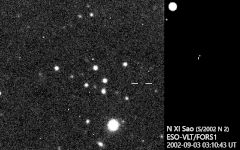Sao (księżyc)
| ||
 | ||
| Planeta | Neptun | |
| Odkrywca | Matthew Holman, John Kavelaars, Tommy Grav, Wesley Fraser i Dan Milisavljevic[1] | |
| Data odkrycia | 14 sierpnia 2002[1] | |
| Tymczasowe oznaczenie | S/2002 N 2 | |
| Charakterystyka orbity | ||
| Półoś wielka | 22 619 000 km[2] | |
| Mimośród | 0,2827[2] | |
| Okres obiegu | 2919,16 d[2] | |
| Nachylenie do ekliptyki | 49,907°[2] | |
| Długość węzła wstępującego | 60,354°[2] | |
| Argument perycentrum | 65,047°[2] | |
| Anomalia średnia | 168,139°[2] | |
| Własności fizyczne | ||
| Średnica równikowa | 40 km[3][4] | |
| Powierzchnia | 6082 km²[5] | |
| Objętość | 44 602 km³[5] | |
| Masa | 8,99 × 1016 kg[5] | |
| Średnia gęstość | 1,5 g/cm³[5] | |
| Przyspieszenie grawitacyjne na powierzchni | 0,012 m/s²[5] | |
| Prędkość ucieczki | 84 km/h[5] | |
| Albedo | 0,04[4] | |
| Jasność obserwowana (z Ziemi) | 25,4m[3] | |
Sao (Neptun XI) – mały, nieregularny naturalny satelita Neptuna. Został odkryty przez Matthew Holmana i in. w sierpniu 2002 za pomocą teleskopów naziemnych w Międzyamerykańskim Obserwatorium Cerro Tololo i na Hawajach[1].
Otrzymał tymczasowe oznaczenie S/2002 N 2. Został nazwany od Sao, jednej z nereid z greckiej mitologii[1].
Krąży wokół Neptuna w średniej odległości ok. 22 619 000 km[2], zgodnie z kierunkiem obrotu planety wokół własnej osi[1]. Jedno okrążenie zajmuje Sao ok. 8 lat[1][2].
Zobacz też
- Chronologiczny wykaz odkryć planet, planet karłowatych i ich księżyców w Układzie Słonecznym
- Księżyce Neptuna – zestawienie podstawowych danych
Przypisy
- ↑ a b c d e f Sao: In Depth (ang.). W: Solar System Exploration [on-line]. NASA. [dostęp 2018-12-24].
- ↑ a b c d e f g h i Planetary Satellite Mean Orbital Parameters (ang.). Jet Propulsion Laboratory, 2013-08-23. [dostęp 2015-04-26].
- ↑ a b Scott S. Sheppard: Neptune's Known Satellites (ang.). [dostęp 2015-04-26].
- ↑ a b David R. Williams: Neptunian Satellite Fact Sheet (ang.). NASA, 2013-07-19. [dostęp 2018-12-24].
- ↑ a b c d e f Sao: By the Numbers (ang.). W: Solar System Exploration [on-line]. NASA. [dostęp 2018-12-24].
Media użyte na tej stronie
This is a revised version of Solar_System_XXIX.png.
Autor: Brett J. Gladman et al./European Southern Observatory, Licencja: CC BY 4.0
Animation of three 420-second exposures of Neptune's irregular moon Sao, imaged as a slow-moving 25th magnitude object by Brett J. Gladman et al. with the ESO's VLT-FORS1 imager on 3 September 2002. These images were taken as part of follow-up observations of Neptune's five irregular moons discovered by Gladman et al. in the month before (August 2002).
Uploader's notes: The original NASA/Cowart PNG image has been modified by flattening (combining layers), cropping and converting to JPEG format.
Original caption released with image:
Voyager 2 Narrow Angle Camera image of Neptune taken on August 20, 1989 as the spacecraft approached the planet for a flyby on August 25. The Great Dark Spot, flanked by cirrus clouds, is at center. A smaller dark storm, Dark Spot Jr., is rotating into view at bottom left. Additionally, a patch of white cirrus clouds to its north, named "Scooter" for its rapid motion relative to other features, is visible.
This image was constructed using orange, green and synthetic violet (50/50 blend of green filter and UV filter images) taken between 626 and 643 UT.
Image Credit: NASA / JPL / Voyager-ISS / Justin Cowart


